With five national parks, two of which are designated World Natural Heritage Sites by UNESCO, and several wildlfe and bird sanctuaries, Assam is a blessed land for wildlife enthusiasts. At the heart of it's mind boggling biodiveristy is the rich topography of Assam with it's lush hills and valleys dissected by the majestic Brahmaputra and it's many tributaries.
Assam is home to over 180 species of mammals, including rare and endangered species like the great Indian one-horned rhinoceros, the royal Bengal tiger, the golden langur and hoolock gibbon, and a spectacular range of avifauna.
Assam's most famous parks are Kaziranga and Manas. Both were conferred World Heritage Status in 1985.
Kaziranga National Park is spread over 858 sq.kms and is located in the floodplains on both sides of the Brahmaputra river. Patches of mixed deciduous forests are interspersed with vast stretches of savannah grasslands, wetlands and chars of river islands formed by the shifting course of the Brahmaputra.
The park is divided into five ranges - Central (entry point at Kohora), Western (entry point at Bagori), Eastern (at Agratoli), Western-most Burha Pahar (at Ghorakati) and Northern. The first four lie on the southern side of the river while the last is on the northern bank.
A memorable way of exploring Kaziranga is on eleplant-back as these gentle creatures tread through the tall grass. The park's prized possessions, the rhinos, are usually found in good numbers grazing with deer and buffaloes.
Another option is to see the park is to take the jeep safari which is also highly recommended, as it offers the added benefit of covering a vast expanse in a relatively short span of time.
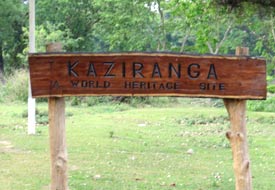 | 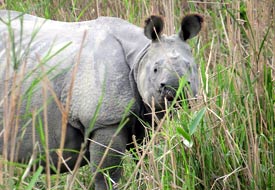 |  |
While on safari, visitors to the park are well advised not only to abide by park etiquettes but also to bear in mind its conservation history, officially counted as the most successful conservation initiative in the sub continent in the 20th century (Kaziranga Centenary: Celebrating the Century's Greatest Success Story, 2005) Originally established as a reserve forest in 1908, Kaziranga was declared a sanctuary in 1916 to counter extensive poaching of the rhinoceros. In 1974, the Indian Government demarcated the present area as a national park. Then, in 2007, it was declared a tiger reserve under the Central Government's Project Tiger scheme.
The Park is the abode to more than 70% of One Horned Rhinoceros in the world. Highest density of tigers' prey including the large prey biomass of tiger found in the country.
Located in the Himalayan foothills in western Assam, Manas was originally a game reserve since 1928 and became a Tiger Reserve in 1974, a World Heritage Site in 1985, a Biosphere Reserve in 1989. Then declared as a National Park in 1990. The park is contiguous with the Buxa Tiger Reserve in West Bengal and in 2003, it was declared part of Chirang-Ripu Elephant Reserve which serves as the international corrdior for elephant migration between Indian and Bhutan. Spread over an area of 500 sq. kms., the park has extensive grasslands and is famous for its unique scenic beauty. The park harbours more than 20 endangered species.
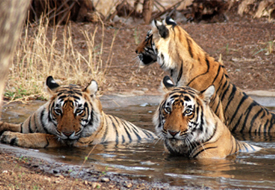 | 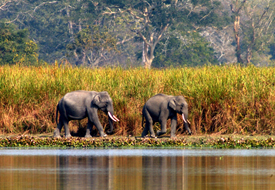 | 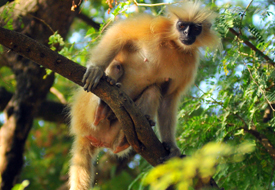 |
Considered one of the the world's rarest simian species, the golden langur was first spotted in Manas in the mid 20th century. Other mammals commonly found here are Rhino, Elephant, Tiger, Pygmy hog, Hispid hare, Assamese Macaque, Rhesus Macaque, Leopard, Golden Cat, Clouded leopard, Fishing cat, Leopard cat, Jungle Cat, the Large Indian civet, the Small Indian civet, Common palm civet or Toddy cat, Himalaya palm civet, Binturong, Common mongoose, Small Indian mongoose, Himalayan black bear, Sloth bear, Gaur, Water buffalo, Sambar, Hog deer, Barking deer, Swamp deer, Wild pigs etc.
How to reach : Located 176 kms from Guwahati and Barpeta Road Railway Station is 20 Kms. away.
Contact Person: Director, Manas National Park Contact Numbers: +91 3666-261413 / +91 3666-260288
Best season to visit: November to April
Pabitora’s area is just 38.81 sq km, but it has the world’s highest concentration of rhinos (93 as per the 2012 census). It is a microcosm of Kaziranga, so much so that it is often referred to as national park’s showroom ideal for visitors with little time to spare. One can choose to travel to and from Guwahati and explore the sanctuary on elephant back in less than a day or stay overnight at the forest and tourist bungalows. Distance from Guwahati: 35 km (east)
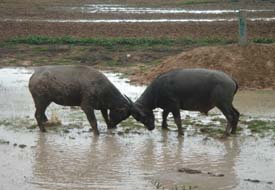 | 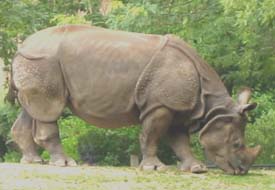 |